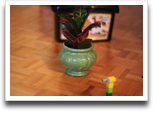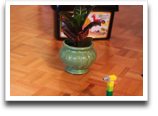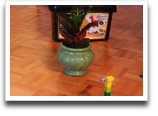This morning, I decided to do a study suggested in an article I read last night about understanding the concept of depth of field.
I set-up three objects (a LEGO box, a vase and a LEGO object) in a straight line, each about a foot apart, switched the camera to aperture priority (Av), dropped the f-stop value to the lowest setting (f/1.4), focused on the middle object (the vase) and took a picture. Then, I changed the f-stop to the next highest setting and took a picture, and continued until the maximum f-stop (f/22).Below are three selections of the study: a low f-stop, a higher f-stop and a large f-stop.
(Aside: I think "depth-of-field" should really be called "area-of-bluriness".) Eric noted that digital cameras make it easy (i.e. inexpensive) to experiment like this and that an alternate name is "circle-of-confusion".



No comments:
Post a Comment